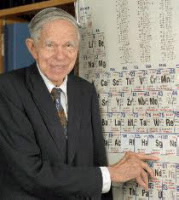ACS President: Glenn T. Seaborg (1912-1999)
Served as President: 1976
He advised ten presidents from Harry S. Truman to Bill Clinton on nuclear policy
Made the public announcement of the production of new elements during the Manhattan Project while appearing on a kids quiz show
Education:
- Ph.D., 1937, University of California, Berkeley, Chemistry
Career Highlights:
- Instructor and Assistant Professor, chemistry, University of California, Berkeley, 1939–1942
- Section Head, Manhattan Project, Wartime Metallurgical Laboratory, University of Chicago, 1942-1946
- Professor, chemistry, and Director, Division of Nuclear Chemistry, Lawrence Radiation Laboratory, University of California, Berkeley, 1946-1958
- Second Chancellor, University of California, Berkeley, 1958-1961
- Chairman, United States Atomic Energy Commission, 1961-1971
- Professor, chemistry, University of California, Berkeley, 1971-1988
Notable Accomplishments:
Principal or co-discoverer of ten transuranium elements, one of which was element 106, Seaborgium, which was named for him while he was still living. Pioneer in nuclear medicine. Synthesized more than 100 atomic isotopes. Identified the actinide concept which led to the current arrangement of the actinoid series in the periodic table. While involved in the Manhattan Project, he developed the extraction process used to isolate the plutonium fuel for the second atomic bomb. Pushed for commercial nuclear energy and peaceful applications of nuclear science.
Major Awards and Honors:
- Named one of the “Ten Outstanding Young Men in America, U.S. Junior Chamber of Commerce, 1947
- Nobel Prize in Chemistry, 1951
- Franklin Medal, Franklin Institute, Philadelphia, PA, 1963
- Perkin Medal, American Section of the Society of the Chemical Industry, 1957
- Priestley Medal, ACS, 1979
- Elected foreign member, Royal Swedish Academy of Sciences, 1972
- National Medal of Science, 1991
- Gilman Hall on the UC Berkeley campus where Seaborg did his work of discovery of plutonium has since been declared a National Historical Chemical Landmark, 1997 [put link in here]
- Posthumously inducted into the National Inventors Hall of Fame, 2005
Service to Science:
- Principal author, “Seaborg Report on Academic Science”, issued in the late ‘50’s
- President, American Association for the Advancement of Science, 1972
- Member, National Commission on Excellence in Education, and key contributor to its report, “A Nation at Risk”, 1983
- Chair, California Academic Standards Commission’s Science Committee, 1994-1998, which prepared the “Science Content Standards for California Public Schools”, 1998
Did You Know
. . . that he received so many awards and honors that he was once listed in the Guinness Book of World Records as the person with the longest entry in Who’s Who in America?
. . . that he kept a daily journal from 1927 to 1999?
. . . that he was not interested in science until his junior year when he was influenced by a chemistry and physics teacher at David Starr Jordan High School in Watts?
. . . that with Dr. Livingood, Seaborg created an important isotope of iodine which was later credited with prolonging his mother’s life?


